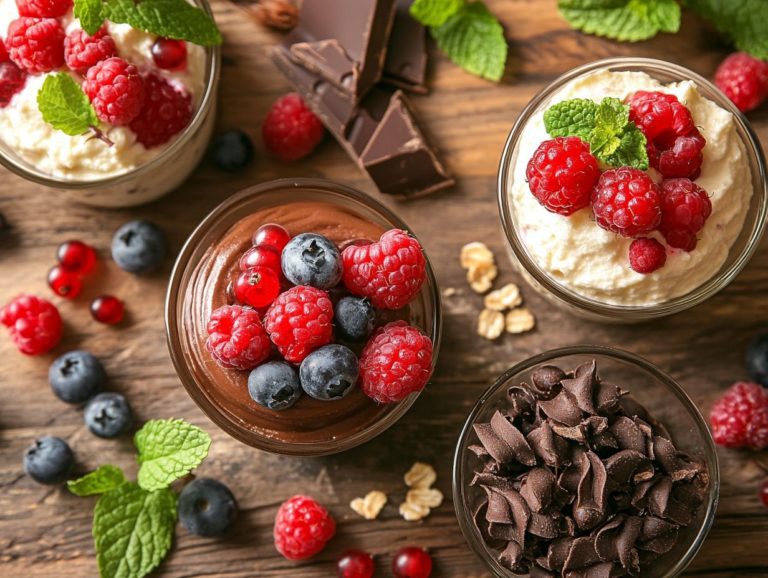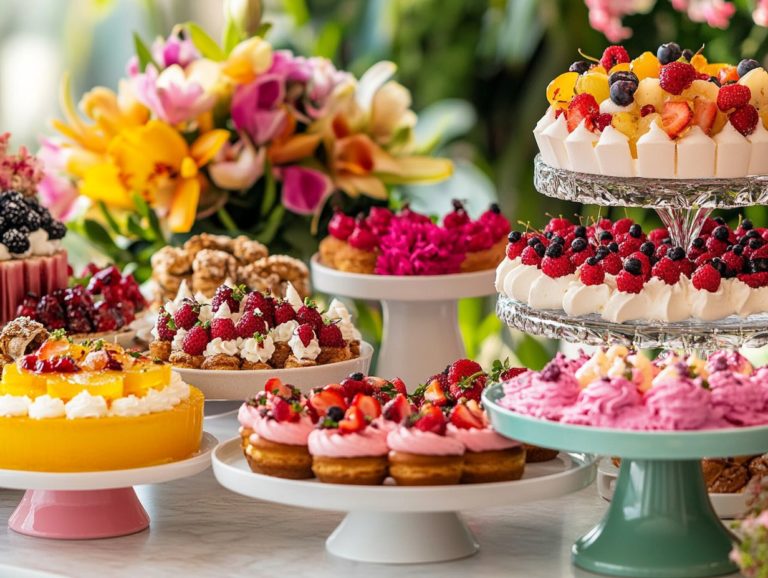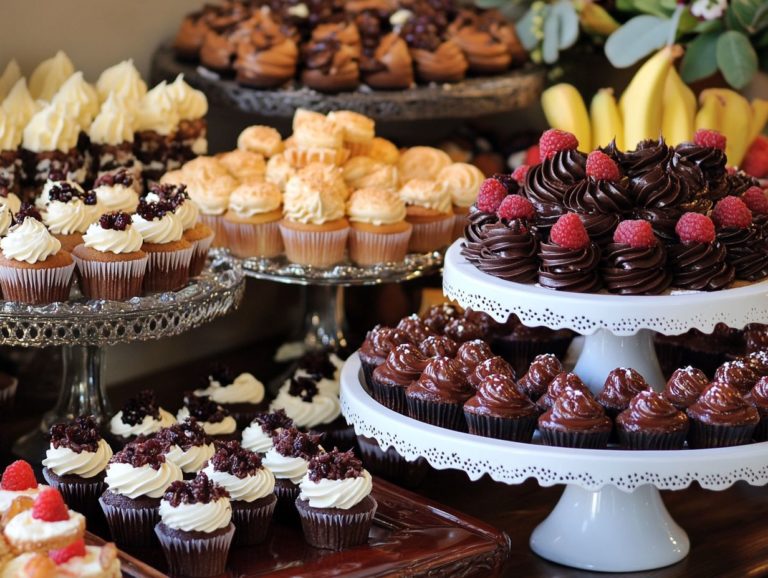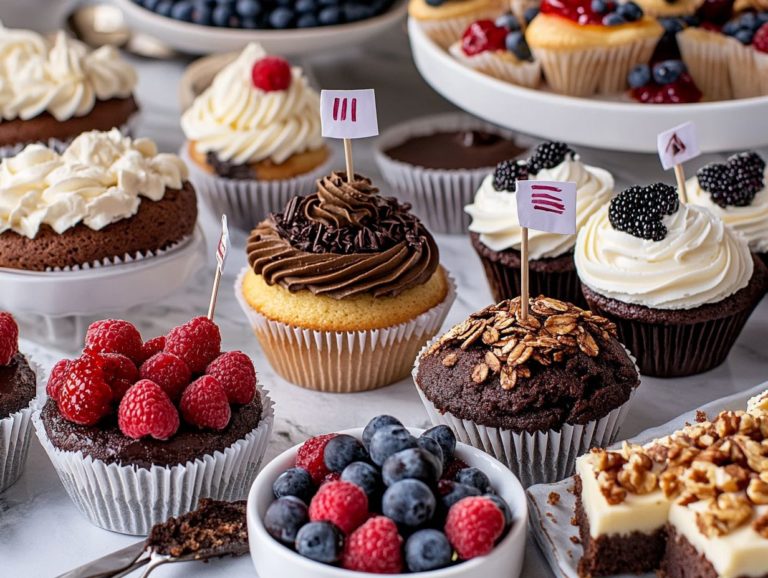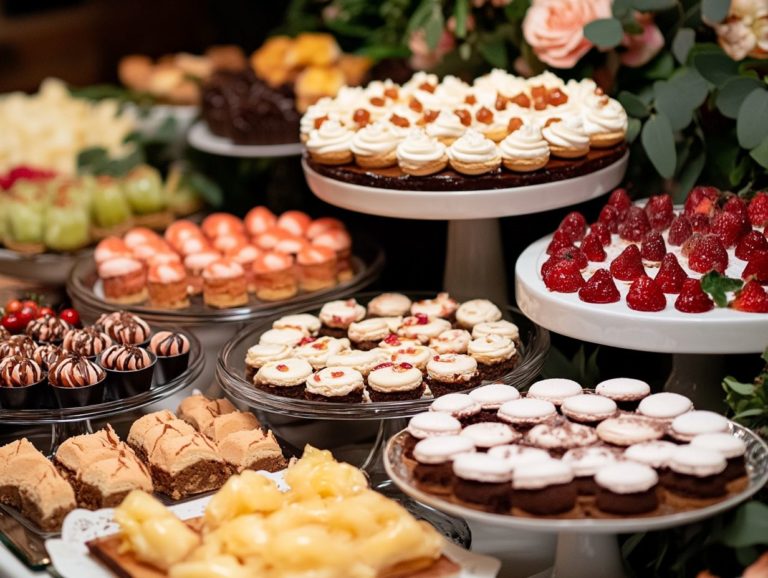How to Make a Dessert Food Diary?
If you have a sweet tooth and take pleasure in indulging in delectable desserts, keeping a dessert food diary can be an enlightening experience. This valuable tool not only allows you to track your dessert consumption but also helps you gain a deeper understanding of your cravings and eating habits, including your favorite dessert recipes like frosted chocolate cake and berry dump cake.
Explore what a dessert food diary is, discover its benefits, and learn how to start your own. Including essential elements and utilizing tips effectively, like those from Pioneer Woman and Magnolia Market, can enhance your relationship with sweets.
Embark on this delicious journey and savor every moment, whether you’re enjoying a classic like key lime pie or a unique treat like potato candy!
Contents
- Key Takeaways:
- What Is a Dessert Food Diary?
- Why Keep a Dessert Food Diary?
- How to Start a Dessert Food Diary?
- Your Guide to Keeping a Dessert Food Diary
- 1. Choose a Format for Your Diary
- 2. Decide on the Frequency of Entries
- 3. Set Goals and Record Them
- What to Include in Your Dessert Food Diary?
- How to Use Your Dessert Food Diary?
- 4. Share with a Professional
- Frequently Asked Questions
- 1. What is a dessert food diary and why should I make one?
- 2. How do I start making a dessert food diary?
- 3. Can I include both homemade and store-bought desserts in my diary, such as from Costco?
- 4. How often should I update my dessert food diary?
- 5. What should I include in my dessert food diary entry, such as for a dessert table or a drink table?
- Using Your Dessert Diary for Healthier Choices
Key Takeaways:

- Keeping a dessert food diary helps you be more conscious of your dessert consumption and make healthier choices.
- Start your dessert food diary by choosing a format and setting goals for yourself. Record the date, type of dessert, portion size, nutritional information, baking tips, and your emotions and thoughts.
- Use your dessert food diary to track progress, identify patterns and triggers, make adjustments to your diet, and share with a professional like Sue Gronholz or Nick Iverson if needed.
What Is a Dessert Food Diary?
A dessert food diary is a record of the delicious desserts you enjoy over time. Imagine capturing the essence of chocolate cake, the classic charm of apple pie, the enjoyment of turtle cheesecake, and even the creativity of unique offerings like ricotta cheesecake, lemon layer cake, or apricot-hazelnut triangles.
This diary is an invaluable resource, allowing you to track your dessert habits, explore a variety of sweet delights, and elevate your party planning game. With this tool, you can wow your guests with a stunning dessert table that will leave them in awe, whether you’re using Costco flowers or tips from Overtime Cook.
Why Keep a Dessert Food Diary?
Maintaining a dessert food diary is an exceptional method for monitoring your dessert consumption patterns. This approach enables you to pinpoint your favorite treats while tracking the logistics of seamlessly incorporating various desserts into your diet, like bourbon pecan pie or cheesecake bars.
By documenting your encounters with delightful confections such as baklava squares, Mississippi mud pie, and snickerdoodle cheesecake, you can uncover valuable insights into your preferences. This knowledge allows you to make informed decisions about your dessert selections, whether you re attending themed parties or enjoying casual gatherings with friends, perhaps at a place like The Gathering Place.
How to Start a Dessert Food Diary?
Consider seeking inspiration from sources like Costco or Best Select to find the best ingredients and tools for your dessert creations.
Starting a dessert food diary is an enriching endeavor that requires a few essential steps to document your delightful journey through an array of desserts, from indulgent chocolate almond drops to timeless peach crumb bars, and even whimsical treats like macaroon cobbler.
Begin by selecting the perfect medium for your entries, whether it s a beautifully crafted journal or a sleek digital format. Pair your delectable creations with thoughtfully chosen serving dishes to elevate the presentation, perhaps inspired by styles from Magnolia Market.
This organized approach will enhance your dessert experiences and set the stage for truly spectacular dessert tables at your future gatherings.
Start your dessert journey today, and discover the joy of tracking your sweet moments!
Your Guide to Keeping a Dessert Food Diary
1. Choose a Format for Your Diary
Choosing the right format for your dessert food diary is essential, as it can greatly influence how effortlessly you track your sweet treats. Whether you lean towards a digital format or prefer the charm of a traditional handwritten diary, each option has distinct advantages. Reviewing suggestions from experts like Barbara Allen or Gloria Bradley can provide valuable insights.
A handwritten diary offers a personal touch, allowing you to connect more intimately with your entries. In contrast, a digital format provides unparalleled accessibility and the convenience of incorporating dessert logistics and recipes with ease.
Consider this: digital tools can provide features such as cloud storage, ensuring that your dessert entries are not only backed up but also accessible from any device, anytime. This capability makes it easy to search for specific recipes or analyze trends in your dessert consumption over time, like when you enjoyed red velvet cake or trail mix slices.
Conversely, a handwritten diary can spark creativity, giving you the freedom to doodle, sketch, or attach pictures, resulting in a more engaging experience. However, keep in mind the potential hurdles of organization and the fact that writing by hand can be time-consuming.
Ultimately, the decision between these formats comes down to your personal preference and how you envision capturing the delightful journey of exploring desserts.
2. Decide on the Frequency of Entries
Deciding how often to jot down entries in your dessert food diary is crucial for maintaining consistency. Whether you opt to log your treats daily, weekly, or after each delightful recipe you try, establishing a regular routine allows you to capture a wide range of dessert experiences from luscious chocolate cakes to invigorating raspberry ice cream. This way, you ensure that every sweet moment is documented.
By setting a practical schedule for these entries, you cultivate a habit and unlock valuable insights into your dessert preferences and patterns. This systematic approach helps you identify consumption trends, allowing you to reflect on your choices and make informed decisions for future gatherings.
Consistently tracking your dessert consumption can significantly streamline your planning for dessert commitments. This might mean determining portion sizes or selecting recipes that resonate with your guests, like the delicious carrot cake cookies that everyone loves or the creamy raspberry icebox cake. Ultimately, this methodical practice enriches your dessert experience and encourages more mindful indulgence, leading to greater enjoyment at social events.
3. Set Goals and Record Them
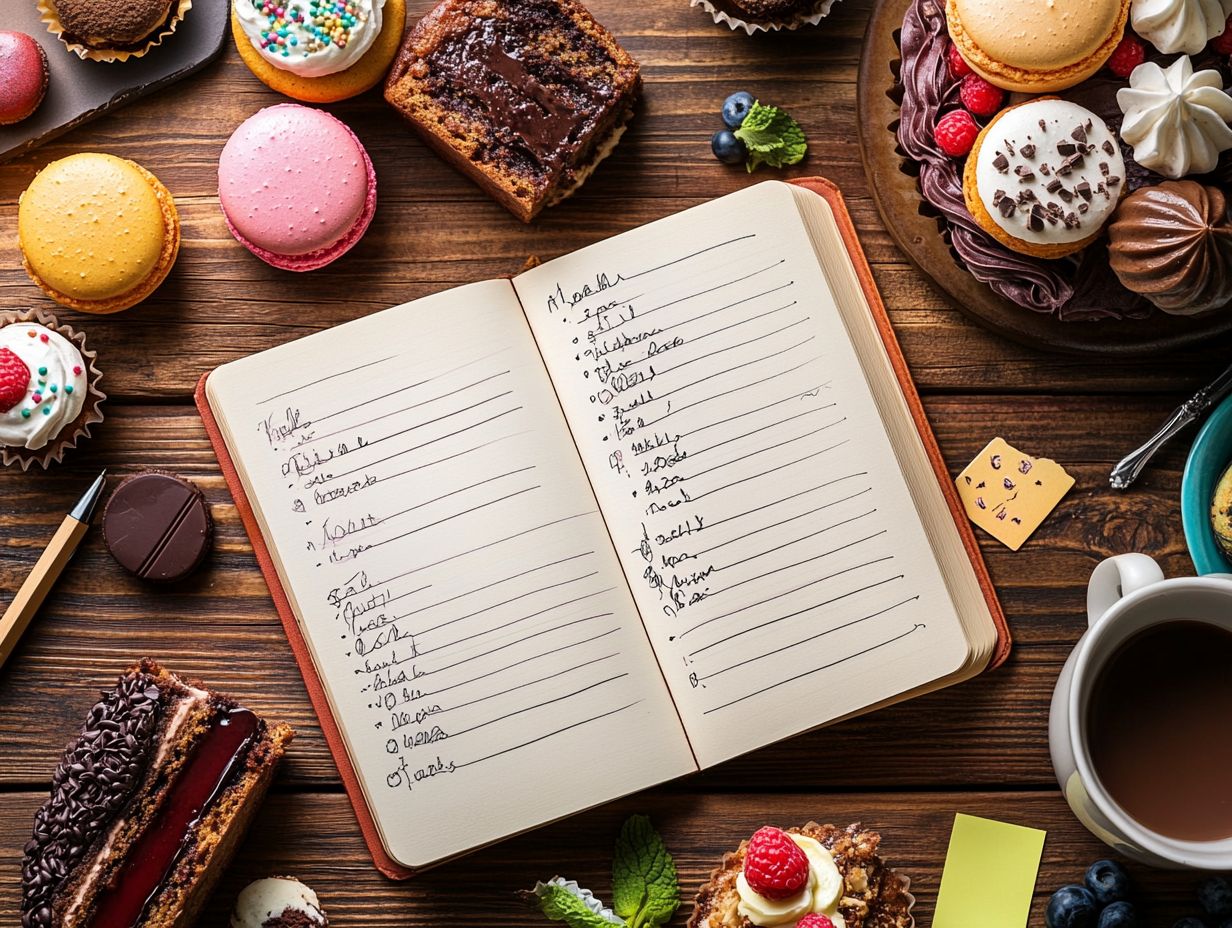
Setting goals in your dessert food diary can truly elevate your experience, providing both motivation and direction as you track your dessert consumption and explore delightful recipes like caramel shortbread cookies or chocolate peanut butter delights. By recording these goals, you create an opportunity to reflect on your progress and make adjustments to your dessert habits, ensuring a balanced approach to your sweet indulgences.
Consider creating specific, measurable, and achievable goals, such as limiting your dessert intake to three times a week or trying a new recipe each month. Diligently tracking these targets in your diary allows you to assess what aligns best with your lifestyle and make adjustments as needed.
Reflection is key; after a month, take a moment to look back and evaluate whether you ve met your goals or if it s time for a change.
This thoughtful process encourages mindful indulgence and enriches your overall dessert experience, transforming it into something more satisfying and meaningful.
Start your dessert diary today and discover your sweet preferences!
What to Include in Your Dessert Food Diary?
When documenting in your dessert food diary, it’s essential to capture key details such as the date and time of each delightful indulgence, the names of the desserts you savored, and the portion sizes. This creates a comprehensive picture of your dessert experiences. Don’t forget to note the dessert names like butter toffee or blueberry ice pops for a richer record.
Moreover, noting the nutritional information and incorporating baking tips can deepen your appreciation for the treats you enjoy. Whether you relished a decadent turtle cheesecake, a refreshing berry ice pop, or delightful mini cheesecakes, this information will enhance your experience.
1. Date and Time of Dessert Consumption
Recording the date and time of your dessert consumption in your dessert food diary is an essential practice. It allows you to track your eating habits and uncover trends over time.
You might notice, for instance, that you enjoy a rich chocolate layer cake on weekends while opting for lighter choices like berry tartlets during the week. This information is invaluable for comprehending your dessert patterns and making informed choices in the future.
These insights can help you plan a dessert buffet or drink table more effectively. By diligently noting these entries, you can gain insights into your preferences and the frequency of your indulgences.
You may even discover emotional triggers tied to your dessert selections. For example, you might find that Wednesdays consistently spark a craving for creamy cheesecake, hinting at a potential midweek treat tradition.
To keep this information organized, consider implementing a straightforward system of tags or categories in your diary, such as celebration , stress relief , or weekend treat . This streamlines the process and enables you to draw quicker conclusions about your habits.
Periodically reviewing these entries will deepen your understanding of how various factors influence your dessert enjoyment. What desserts are you excited to document in your diary?
2. Type of Dessert
Documenting the type of dessert in your food diary is absolutely essential. It allows you to categorize and analyze your favorite recipes, whether it s a decadent chocolate pots de cr me or a zesty key lime pie.
By tracking the variety of desserts you enjoy, you’ll gain a deeper understanding of your preferences. You may even stumble upon new favorites along the way!
Variety is key what new dessert will you try next? Consider the classics, like velvety vanilla bean panna cotta or irresistible strawberry shortcake.
Don t hesitate to experiment with different recipes or seasonal ingredients; this can lead to wonderful culinary discoveries. You might just find that you have a newfound affection for a spiced pumpkin tart come fall or a lemon layer cake in spring.
Exploring diverse flavors not only keeps dessert time exciting but also sparks creativity in the kitchen. Consider trying different dessert varieties such as key lime pie or turtle cheesecake to keep things interesting.
3. Portion Size
Tracking the portion size of desserts in your food diary is essential for gaining insights into your dessert consumption habits. This also helps manage your overall intake. Whether you enjoyed a delicate slice of carrot cake or a big scoop of raspberry ice cream, paying attention to portion sizes can help you find balance.
Recording the size of each dessert acts as a tangible reminder of your consumption. This fosters greater awareness and enables you to make healthier choices.
To estimate portion sizes accurately, consider using measuring cups or a kitchen scale. These tools provide precision that guessing simply can’t match.
Taking a moment to visually compare portions to everyday items can also be beneficial. For example, think of a serving size that resembles a standard light bulb for cakes or a quarter for ice cream.
By logging these details consistently, you cultivate better tracking of your sweet intake. This encourages moderation without sacrificing the joy that comes from indulging in those delicious treats.
4. Nutritional Information
Including nutritional information in your dessert food diary is a wise practice. It deepens your understanding of how your dessert choices impact your overall health, whether you re savoring a rich bourbon pecan pie or opting for a lighter treat like trail mix slices, berry tartlets, or apricot-hazelnut triangles.
This awareness helps you choose desserts that fit your health goals while promoting moderation and mindful indulgence. Leveraging resources such as nutrition labels, which provide details about the ingredients and their nutritional value, online databases, and specialized mobile apps can greatly streamline this process.
For instance, platforms like MyFitnessPal and USDA’s FoodData Central offer comprehensive data on a wide array of dessert options, from snickerdoodle cheesecake to chocolate pots de cr me. Many food bloggers also provide delightful homemade dessert recipes complete with nutritional breakdowns, enabling you to make healthier choices without compromising on enjoyment. Blogs like those of Overtime Cook and Pioneer Woman are great resources.
5. Feelings and Cravings
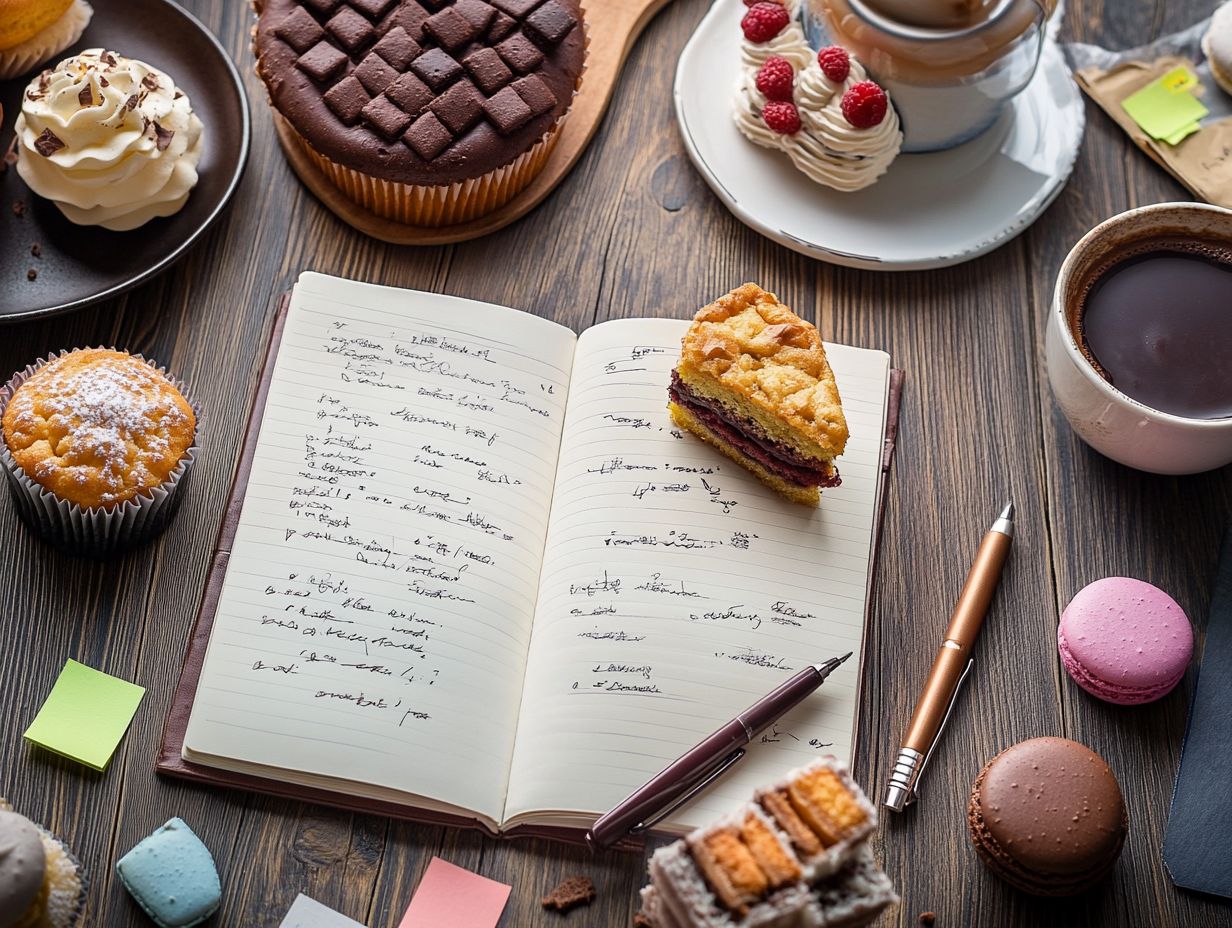
Documenting your feelings and cravings in your dessert food diary can unlock profound insights into your emotional relationship with sweets. You might notice a preference for chocolate cake during stressful times or a craving for apple pie tartlets during celebrations.
This practice helps you uncover the triggers that spark your sweet cravings, whether it s the irresistible allure of chocolate almond drops, the crunchy delight of potato candy, or the comforting nostalgia of a warm slice of apple pie. By being mindful of these emotions, you can navigate your dessert choices with greater awareness and savor them without guilt.
This approach enables you to recognize patterns associated with different desserts. Certain flavors can evoke cherished memories or provide comfort during both stressful times and celebrations.
For instance, a scoop of vanilla ice cream may transport you back to carefree childhood summer days, filling you with a sense of joy that elevates your dessert experience. Similarly, macaroon cobbler could remind you of family gatherings, making the moments even more special.
Conversely, a slice of decadent cheesecake might symbolize a well-deserved reward for your hard work, transforming a simple treat into a powerful motivator. By encouraging you to reflect on your own emotional connections to these sweet delights, you can cultivate a deeper appreciation for the moments that dessert can enhance.
Ultimately, this reflection can transform your approach to indulgence, leading to a more meaningful and joyful experience with every bite.
6. Notes and Comments
Adding notes and comments to your dessert food diary can truly elevate your documentation. This provides rich context about each dessert experience and facilitates better party planning for future gatherings.
Whether you’re reviewing how that decadent chocolate cake turned out, reminiscing about frosted chocolate cake, or sharing a personal anecdote about relishing berry dump cake at a family gathering, these reflections deepen your understanding of your dessert journey. They also fuel innovation for future culinary adventures.
When you record specific details, like the adjustments made to a recipe, you re not just jotting down notes; you re creating a valuable resource for your future baking sessions. Maybe you experimented with swapping out regular flour for almond flour or added an unexpected hint of salt to that caramel sauce, transforming a good dessert into an extraordinary one.
Perhaps you created cheesecake bars with unique twists or tried out different types of shortbread cookies. Sharing the emotions tied to these occasions brings an additional layer of depth and could be insightful for future themed party plans.
Remembering the laughter shared with friends over slices of pie or the triumphant satisfaction when your baking masterpiece succeeded against all odds adds a personal touch. These insights not only let you revisit cherished memories but also guide you in honing your craft while reliving those sweet, delightful moments.
How to Use Your Dessert Food Diary?
Having a dessert food diary helps you track your eating desserts and trying new recipes. This gives you insights into your habits and preferences. It’s especially helpful when you’re planning a dessert buffet or organizing a dessert table for events. By reviewing your entries consistently, you’ll discover exciting patterns, improve your dinner selections, and make sure your sweet treats are always delightful whether you’re making rich chocolate pots de cr me or enjoying caramel shortbread cookies.
1. Track Your Progress
Tracking your progress in your dessert food diary is invaluable. It lets you evaluate your dessert habits over time, whether you re enjoying treats like baklava squares or trying to cut back on Mississippi mud pie. Reflecting on your entries helps you recognize your successes and find areas for improvement.
To maximize the benefits of tracking, periodically review your diary maybe weekly or monthly. This helps you understand your dessert habits better and plan better serving dishes. Setting practical goals, such as limiting your desserts to a certain number every week or committing to try a new dessert each month, gives you clear targets to aim for.
Celebrate your achievements, no matter how small! Whether it s mastering a new recipe, trying new desserts, or successfully moderating your sweet intake, treat yourself to a fun dessert date with friends or a special dessert item. These practices will enhance your experience and make dessert a more mindful and enjoyable part of your life.
2. Identify Patterns and Triggers
Identifying patterns and triggers in your dessert food diary can change the game. You might notice you reach for chocolate peanut butter treats when stressed or that apple pie is your go-to during celebrations. Understanding these triggers helps you manage cravings better and enjoy desserts mindfully.
As you explore your diary, you’ll uncover themes connecting your emotions with your dessert choices. For instance, you may find that you often reach for ice cream during lonely moments or that cookies become your reward after a tough day. Recognizing these feelings as triggers invites you to think about why certain situations spark cravings.
This reflective process boosts your awareness and can help you develop healthier coping strategies, like finding comfort in activities that don’t involve food, ultimately enriching your relationship with dessert.
3. Make Adjustments to Your Diet
Adjusting your diet based on insights from your dessert food diary can lead to healthier choices that still satisfy your sweet tooth. Consider swapping rich desserts for lighter options like berry ice pops or raspberry icebox cake, or try healthier recipes like trail mix slices. These changes can enhance your dessert experience while promoting a more balanced lifestyle.
Take a moment to review your dessert habits; this self-reflection might reveal patterns you weren t aware of. If chocolate cake is a frequent indulgence, why not switch it for dark chocolate avocado mousse? It s creamy, indulgent, and full of nutrients. You could also replace sugary pastries with homemade fruit parfaits or yogurt bowls topped with nuts and honey. Another option is to make carrot cake cookies for a healthy twist on a classic flavor.
By gradually introducing these alternatives, you can make the transition smoother while keeping enjoyment at the forefront of your dessert choices without compromising your health. Baking tips from The Gathering Place or resources like Magnolia Market can inspire your journey!
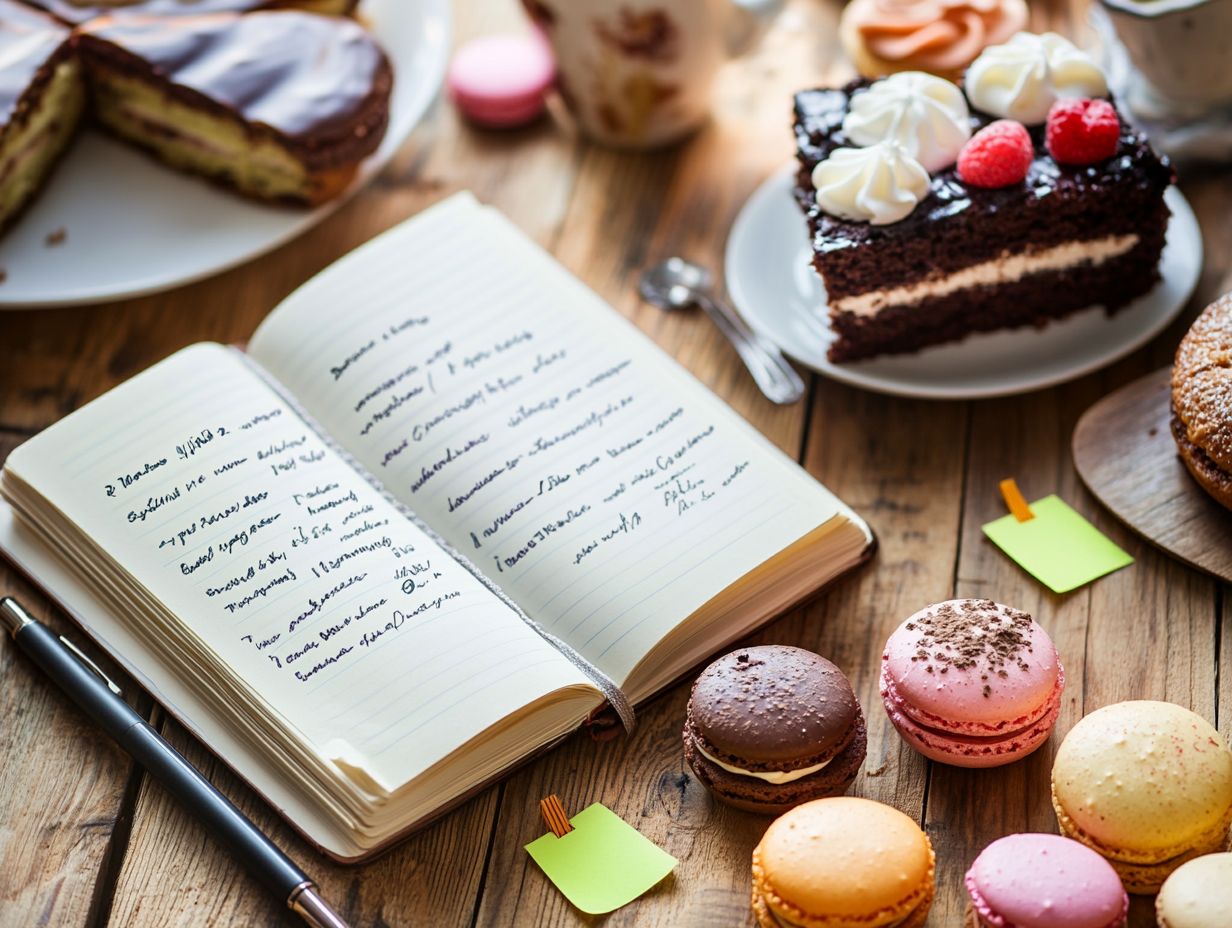
Share your dessert food diary with a nutritionist or dietitian for valuable insights. Experts can provide guidance tailored to your dietary goals. Whether you’re eager to explore healthier dessert options like apricot-hazelnut triangles or gain a clearer understanding of your dessert consumption patterns, collaborating with an expert can elevate your dessert experience.
This partnership enables you to make informed choices about your sweet indulgences such as berry dump cake. These professionals can carefully review your entries to uncover any hidden sugar intake and suggest alternatives that satisfy your cravings without compromising nutrition.
For example, they might recommend swapping out traditional ingredients for healthier options such as potato candy or trail mix slices. This allows you to indulge while keeping your calorie counts in check.
Understanding portion sizes and the frequency of your dessert consumption is pivotal. A dietitian can assist in crafting a balanced approach that aligns perfectly with your health aspirations, perhaps by incorporating smaller portions of mini cheesecakes.
Partnering with a knowledgeable professional can significantly enhance your chances of achieving your dietary goals while still enjoying the sweet pleasures of life like snickerdoodle cheesecake responsibly.
For more delicious dessert inspirations, check out recipes from Pioneer Woman and Overtime Cook.
Famous chefs like Johnna Johnson and Louise Good often share their dessert recipes online. Whether it’s baklava squares or peach crumb bars, their insights can be beneficial for your dessert food diary.
Frequently Asked Questions
For advice on dessert logistics and freeze desserts, consult with experts like Dawn Lowenstein and Mary Ann Lee.
Looking for baking tips? Our FAQ section covers various desserts like key lime pie and chocolate cake in detail, along with insights from chefs like Barbara Allen and Beth Bristow.
1. What is a dessert food diary and why should I make one?
Creating a dessert food diary can help with party planning and tracking different dessert names for your themed party.
A dessert food diary is a record of all the desserts you eat in a given time period. It helps you keep track of your dessert consumption and can be a useful tool for managing your diet and making healthier choices. Knowing what you eat, whether it s lemon layer cake or chocolate peanut butter, can help you make better decisions.
2. How do I start making a dessert food diary?
To get started, you can use apps or templates from websites like Best Select for better organization.
Choose a time period for your diary, such as a week or a month. Then, designate a notebook or use a digital platform to record your desserts. Finally, set a goal for your diary, whether it’s to track your sugar intake or try new dessert recipes like chocolate almond drops or carrot cake cookies.
3. Can I include both homemade and store-bought desserts in my diary, such as from Costco?
Yes! Feel free to include any dessert you crave, from homemade treats like apple pie or blueberry ice pops, to desserts from restaurants and even pre-packaged treats from the grocery store.
4. How often should I update my dessert food diary?
Don’t forget to note if you are experimenting with desserts like raspberry icebox cake or dessert table decorations for your gathering place.
It’s recommended to update your diary after every dessert you consume. This will give you the most accurate record of your dessert consumption and help you identify patterns or areas for improvement.
5. What should I include in my dessert food diary entry, such as for a dessert table or a drink table?
In each entry, include the name and type of dessert, such as Mississippi mud pie or red velvet cake, where you got it from, the date and time it was consumed, and any notes or observations about the dessert. You can also include the serving size and nutritional information if available.
Using Your Dessert Diary for Healthier Choices
By regularly reviewing your dessert food diary, you can identify areas where you consume too much sugar or unhealthy ingredients.
Use this information to make better choices. For example, choose cheesecake bars over butter toffee.
With this approach, you can enjoy your desserts guilt-free and still stick to healthier options!

